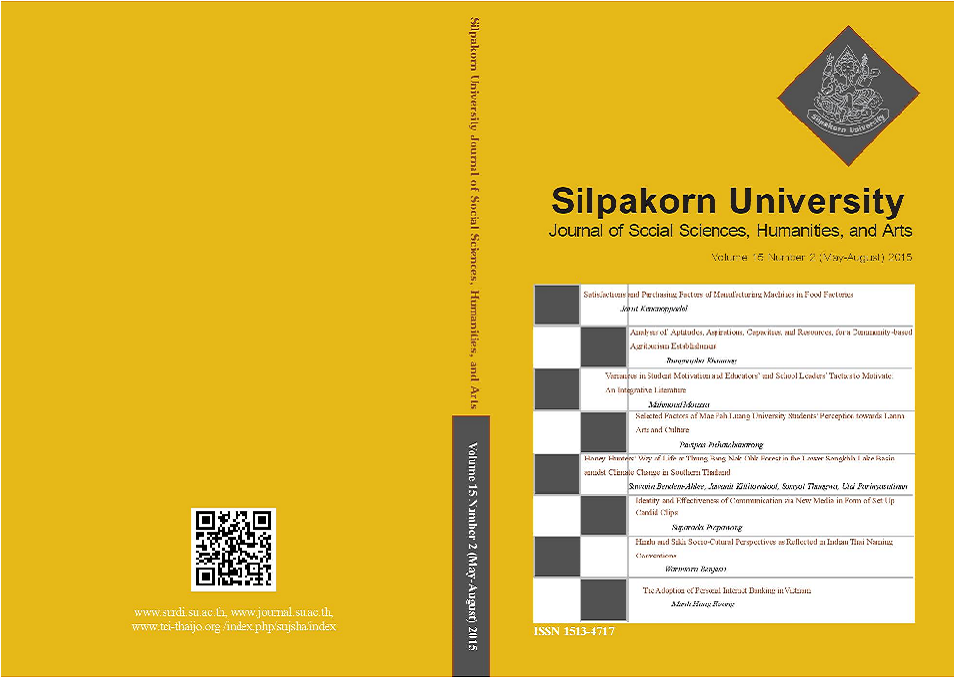Selected Factors of Mae Fah Luang University Students’ Perception towards Lanna Arts and Culture
Main Article Content
Abstract
The main objectives of this study were to examine thesituations, to analyze selected factors and to investigate the perceptionstoward Lanna Arts and Culture (LA&C) of Mae Fah Luang University(MFU) students. Data from 412 undergraduate student questionnaireswere analyzed. Research findings were as follows: 1) Both all situations ofselected factors in terms of Graphic Image and Photographic aspects weresignificantly at the .05 high level; 2) As a result of factor analysis, thefollowing crucial components of LA&C were found: a) three componentsin Graphic Image [namely, Aesthetic, Advertising Value, and NorthernThai Arts and Culture], and b) three components in Photographs [namely,Visual Communication, Visual Culture, and PositivePersuasion] ; and 3)As a result of LA&C selected factors affecting persuasive communicationsof MFU students by Stepwise-multiple regression correlation analysis,it was foundthat: a) four crucial variables had influent to persuasion onGraphic Image at the .05 level of significance, 69.20 percent for predictingthe variance of Graphic Images persuasion, namely Trustworthy, Likable,Attractive, and Beautiful. The best predictor of all four crucial variableswas “Trustworthy”, 56.50% for predicting the Graphic Image persuasionat the .05 level of significance; and b) five crucial variables had influentto persuasion on Photographs at the .05 level of significance, 56.60% forpredicting the Photographs persuasion, namely Trustworthy, Likable,Noble, Northern Arts, and Attractive. The best predictor of all 5 crucialvariables was “Trustworthy”, 45.80% for predicting the Photographs persuasion at the .05 level of significance.
Downloads
Article Details
All rights reserved. Apart from citations for the purposes of research, private study, or criticism and review,no part of this publication may be reproduced, stored or transmitted in any other form without prior written permission by the publisher.
References
Aricat, R., Qinxin, A., Beatrice, M. L., AmnahBteZaihan, S., Zulkifli, S. S., et al. (2014) The Influence of Art on Singaporean Tertiary Undergraduates’ Acculturation Attitude towards Migrant Workers. Online Journal of Communication and Media Technologies 4(1): 148-166.
Belmore, S. M. (1987) Determinants of Attention during Impression Formation. Journal of Experimental Psychology: Learning, Memory, and Cognition 13: 480-489.
Brewer, M. B., Dull, V. and Lui, L. (1981) Perceptions of the Elderly: Stereotypes as Prototypes. Journal of Personality and Social Psychology 41(4): 656-670.
Brown, T., Cash, T. and and Mikulka, P. (1990) Attitudinal Body-Image Assessment: Factor Analysis of the Body-Self Relations Questionnaire. Journal of Personality Assessment 55(1-2): 135-44.
Bucholz, L. M. and Smith, R. E. (1991) The Role of Consumer Involvement in Determining Cognitive Response to Broadcast Advertising. Journal of Advertising 1(20): 4-17.
Burnstein, E. and Schul, Y. (1982) The Informational Basis of Social Judgments: Operations in Forming an Impression of another Person. Journal of Experimental Social Psychology 18(3): 217-234.
Chaiken, S. (1980) Heuristic Versus Systematic Information Processing and the Use of Source Versus Message Cues in Persuasion. Journal of Personality and Social Psychology 39(5): 752-766.
Domke, D., Perlmutter, D. and Spratt, M. (2002) The Primes of our Times? An Examination of the ‘Power’ of Visual Images. Journalism 3(2): 131-159.
Feldman, N. S. and Ruble, D. N. (1977) Awareness of Social Comparison Interest and Motivations: A Developmental Study. Journal of Educational Psychology, 69: 579-585.
Freeman, M. (2001) Lanna Thailand’s Northern Kingdom. Bangkok: Thames & Hudson.
Jeong, S. H. and Hwang, Y. (2008) Persuasive Effect of Visual Metaphors in Advertising: Is It Attributable to Visual Argumentation or Metaphorical Rhetoric? Marketing Communications 14(1): 59-73.
Lester, P. M. (2008) Visual Communications: Image is Everything? [Online URL: https://commfaculty.fullerton.edu/lester/courses/300.html] accessed on December 30, 2008.
Lester, P. M. (2006) Visual Communication: Images with Messages.Boston, MA: Wadsworth Publishing.
Martin, M. C. and Gentry, J. W. (1997) Stuck in the Model Trap: The effects of beautiful Models in Ads on Female Pre-adolescents and Adolescents. Journal of Advertising 26(2): 19-34.
McQuarrie, E. F. and Mick, D. G. (1999) Visual Rhetoric in Advertising: Text-Interpretive, Experimental, and Reader-Response Analyses. Journal of Consumer Research 26(1): 37-54.
Mirzoeff, N. (2009) An Introduction to Visual Culture. London: Routledge. Moriarty, S. E. (2008). A Conceptual Map of Visual Communication. [Online URL: https://www.mediacritica.net/courses/771/moriarty.pdf]. accessed on December 30, 2008.
Pollay, R. W. (1986) The Distorted Mirror: Reflections on the Unintended Consequences of Advertising. Journal of Marketing 50(2): 18-36.
Richins, M. L. (1991) Social Comparison and the Idealized Images of Advertising. Journal of Consumer Research 18(1): 71-83.
Solomon, M. R., Ashmore, R. D. and Longo, L. C. (1992) The Beauty Match-up Hypothesis: Congruence between Types of Beauty and Product Images in Advertising. Journal of Advertising 21(4): 23-34.
Supa, D. (2006) Understanding the Role Visuals Play in Cognitive and Affective Persuasion Processes: Review and Implications. International Communication Association: 1-20.
Stice, E. and Shaw, H. E. (1994) Adverse Effects of the Media Portrayed Thin-ideal on Women and Linkages to Bulimic Symptomatology. Journal of Social and Clinical Psychology 13(3): 288-308.
Tan, A. S. (1985) Mass Communication Theories and Research. New Jersey: John Wiley & Sons Inc. Urban dictionary. (n.d.). Aesthetic. [Online URL: www.urbandictionary.com/define.php?term=Aesthetic] accessed on August 23, 2014.

